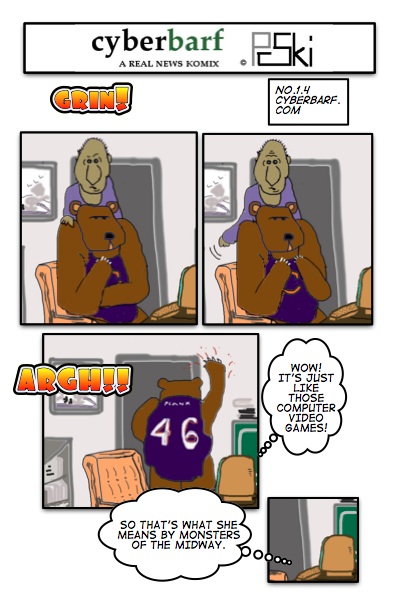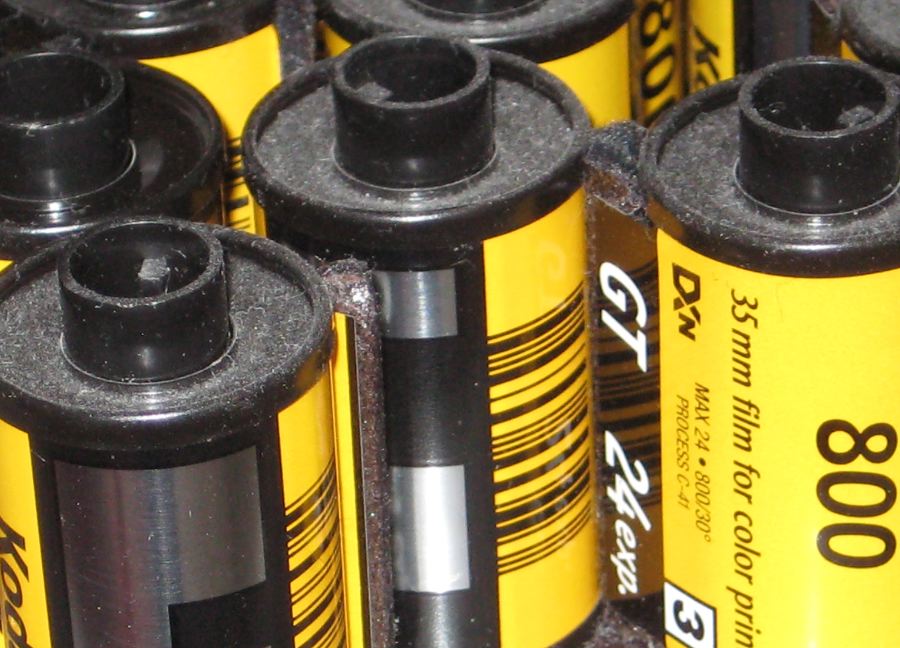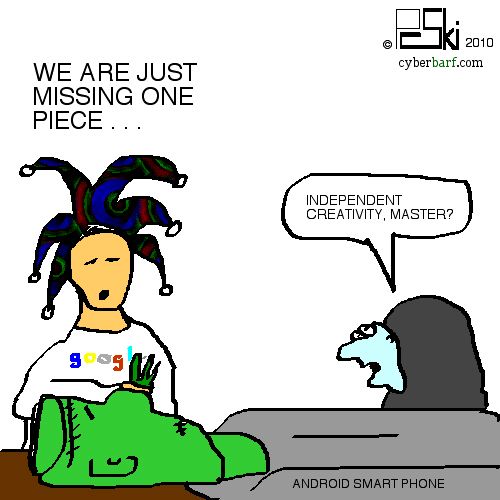|
cyberbarf9.8 EXAMINE THE NET WAY OF LIFE APRIL, 2010 IN THIS ISSUE: PODCAST on YOUR COMPUTER OLD SCHOOL PHOTOGRAPHY NEW cyberbarf KOMIX WHETHER REPORT iTOONS THE DIGITAL FAMILY
|

VISIT THE CYBERBARF STORE! |
READ BOOKMARK BUY READ BOOKMARK BUY READ BOOKMARK BUY READ BOOKMARK BUY READ BOOKMARK BUY |
cyberbarf
EXAMINE THE NET WAY OF LIFE
 |
FOLLOW LOST FIND CLUES ANSWER QUESTIONS EXPLORE LOSTHEORY |
cyberbarf
EXAMINE THE NET WAY OF LIFE
|
cyberbarf OLD SCHOOL PHOTOGRAPHY IN THE CAN Kids used to grow up asking for a little red wagon to play in during the summer or a flexible flyer sled for those snow and ice packed hills in the winter. It is extremely rare today to find kids wandering the neighborhood with any of those nostalgic staples. Stuffed away in dusty desk drawers or in old musty canvas bags, one might find:
An old 35mm camera with telephoto lens, or dozens of unexposed film canisters. While today's shutterbugs have the instant gratification of seeing their picture immediately on the back of their digital camera screen, old school photogs had to wait for the film images captured on film stock to be developed by a chemical process. Originally, Kodak brownie cameras were used by the average family. Pictures were taken, then the whole rig was sent out for development. The usual local film developer was the local pharmacy, which makes sense since at the turn of the last century, pharmacists were chemists by trade, making their own patent medicines. (Side note: most of today's soda beverages have roots as medicinal potions to cure headaches and stomach aches.) One would have to wait weeks in order to see what was captured in the Moment. Polaroid developed the first instant camera. Children and young adults could snap small pictures on a Swinger camera, and watch the device spit out a covered rectangle. You would have to wait approximately a minute, then peel off the paper to expose the finished black and white photograph. For the time, it was really cool to peel back your own photos. If it did not come out right, you could quickly re-do it. More advanced amateur photographers sent their 35mm film rolls to photo labs for processing and printing. There were firms like the Seattle Film Works which developed their film rolls and sent back negatives (for re-prints), 3 x 5 photographs and slides. Yes, families would get together around a projector and watch slide shows of vacations, parties or special events. Today, web sites and computer chipped picture frames take the place of the old fashion family slide show. Digital advances have all but killed off the film development business. The last large film processing plant closed last year. Some professional photographers still use film stock to create their art. They process their own film in chemical baths; then print their images in dark rooms. To a pro, there are darkroom techniques such as dodging and burning parts of the base image that cannot be fully recreated in a digital photography software program. The time, money and expertise needed to keep the chemical processing and printing of photographs is going to be a lost art in a few generations. The ease and cheap camera phones is what most people will immediately think of when someone will ask them in the future about modern photography. But there is something lost by the new instant world. The trip to the drug store to pick up the package of photographs. It is like opening up a holiday present when you take out the pictures. You really don't know what you have until you see it. Photographs still retain a magical quality to them; a permanent capture of a moment in a person's life. A memory forever etched in time. A personal history recorded to be passed down. Except, less and less families have the time or notion to create family photo albums. Instead, their desk drawers are filled with full SD cards (today's version of 35mm canisters). As you can tell, the publisher has a dozen rolls of film cluttering his table that needs to be developed at the local Walgreen's. It is like a personal archaeology dig - - - who knows what buried history is contained in those canisters? |
|
THE PINDERMEDIA STORE IS FULL OF FUN TEE-SHIRTS AND SELECTIONS. FUN . . . . VALUE . . .. FUN . . . . VALUE!
SUPPORT cyberbarf |
 |
MARK ROGSTAD a/k/a ROCKY Tech Guru, Photographer and Educator.
It is fitting that this month's lead article deals with the subject of Old School photography. That was one of Rocky's life long passions.
|
 |
|
NEWS IMPACT EDITORIAL CARTOONS WRIGLEYVILLE WAR POLITICS THE DARK ABYSS ENDORPHIN RUSH SPECIALS |
 |
|
cyberbarf THE WHETHER REPORT |
cyberbarf STATUS |
| Question: Whether e-readers will replace textbooks on college campuses by 2020? |
* Educated Guess * Possible * Probable * Beyond a Reasonable Doubt * Doubtful * Vapor Dream |
| Question: Whether the FCC will try to regulate cable television by increasing its jurisdiction to resolve disputes over network/cable channel access by using concept of net neutrality? |
* Educated Guess * Possible * Probable * Beyond a Reasonable Doubt * Doubtful * Vapor Dream |
| Question: Whether Google's new Android hardware and app store will significantly take away market share from Apple? |
* Educated Guess * Possible * Probable * Beyond a Reasonable Doubt * Doubtful * Vapor Dream |

|
cyberbarf iTOONS
|
|
cyberbarf THE DIGITAL FAMILY FRAYED WIRES “There is no failure that can alter the course of human events more than a failing a family.” - - - Eleanor McGovern. Social engineering is a powerful concept that many leaders have sought to control for their own ends. America was settled by the outcasts and opportunists from other parts of the globe. Based on independent spirit, hard work ethic and the freedom, these immigrants tamed an entire continent. Prosperity is a contagious high. Immigration to the Americas has continued to be the destination for people in all third world countries. The formula was simple: like-minded people banded together to settle untamed wilderness. These groups were dependent upon family as the basic building block for their community. communities formed based upon the same family values shared by all new Americans. The Revolutionary War gave all the communities and colonies the national framework to defend their ideals against foreign threats. A society is a group of people that have formed a single community on related and interdependent individuals. Culture is the result of the refinement of thoughts, emotion, manner, tastes, habits, skills, arts, instruments, and institutions of a given people in a given time period. A civilization is the process of civilizing or becoming civilized through a higher social order, marked by advances in arts and sciences. For two centuries, the United States was the beacon for development in the arts and sciences. Its principles of democracy, manufacturing, technology and freedom was exported throughout the world. People who came to stay in the American civilization were merged into the Great Melting Pot of Society. Immigrants used the newspapers to learn how to read English, used the other media to determine how to act and dress, and used local social clubs to integrate their families into the fabric of the local community. Interpersonal relationships was the mortar that kept all of the building blocks soundly together. Faith, hope and charity were the ties that bound families together with their neighbors. Neighbors watched out for their neighbors. But things changed. Industrialization and mobility caused families to move more often, lessening the sense of community. The melting pot overflowed into burning social revolution. New immigrants sided with depressed minorities to create their own political special interest groups, who vowed not to integrate into mainstream American society, but to hold on to their own language, customs and principles even if they clashed with general laws and behavior. At the same time, the baby boom generation was viewing the world through themselves; “what's in it for me?” is their personal mission statement. The Me Generation pushed their social agenda upon middle class families which increased the stress on the woven fabric of the national identity. Even with all the outside pressures of culture clashes, special interests, mixed messages in the media, the family unit was still the governor in raising children. But time changed the perception of the Ozzie & Harriet 1950s family ideal into the dysfunctional Married with Children model. Recently, the Texas State School Board was in the news. The commission was tasked with re-writing that state's text books. The fire storm brewed when board members wanted to selectively edit history for political correctness, diversity and liberal social engineering. The consequences are clear to those with any common sense: those who don't know history are doomed to repeat it. But the outcry was muted nationally. Where is the modern family, the bedrock of our nation, in this process? Fragmented. For an inner city, rust belt, high unemployment sector, the government entitlement programs pay more welfare dollars to single parent (more likely dysfunctional) families than ones with two parents. For a suburban, service economy, in midst of recession and mortgage foreclosures, for the most part family members are off doing their own thing. Parents are tethered to their children via cell phones and text messaging throughout the day. Their kids are running deep in their own social networks as the base of their lives rather than the social structure of their immediate family. Some parents have left to the schools to teach their children manners, social behavior and boundaries. There is a growing accountability and responsibility gap. In the instant messaging world of family communication, the gaps are growing wider because actual one-on-one communication is more distant. The average American home now contains more digital distractions than ever before: parents have their own cell phones, smart phones and lap top computers (for personal and work) so they are never really away from their non-home life occupations and interests; their children have their own computers, cell phones, hand held video games, massive wide screen television sets and full console players to occupy their time. One of the great problems social service agencies are finding today is that parents and their children spend so little quality time with each other that friction is the only means of communication for them. Digital diversions have made them strangers in their own households. It is hard to imagine how Rockwell could paint the typical modern American family in the Year 2010. It could come down to a still life painting of an empty dining room table. |
 |
 |
 |
THE STEAM PUNK SPECIAL EDITION featured new Music from Chicago Ski & the (audio) Real News:
(mp3/4:14 length)






